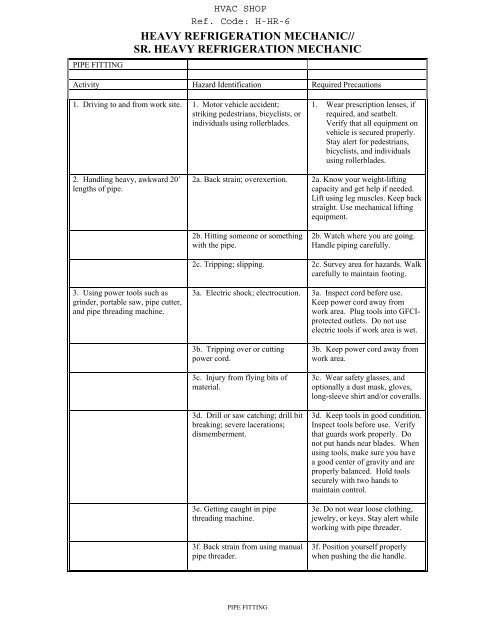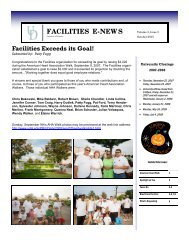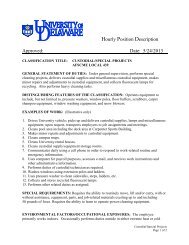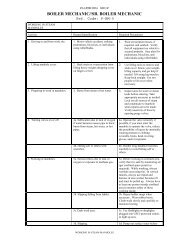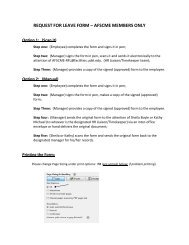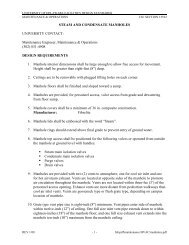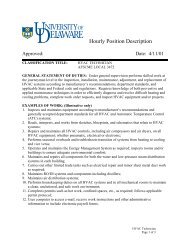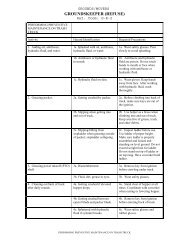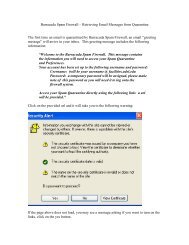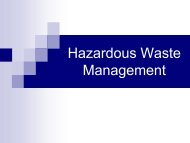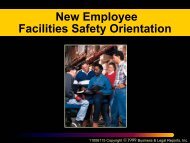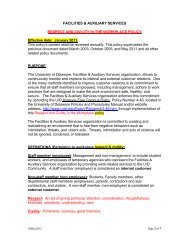PIPE FITTING
PIPE FITTING
PIPE FITTING
You also want an ePaper? Increase the reach of your titles
YUMPU automatically turns print PDFs into web optimized ePapers that Google loves.
<strong>PIPE</strong> <strong>FITTING</strong><br />
HEAVY REFRIGERATION MECHANIC//<br />
SR. HEAVY REFRIGERATION MECHANIC<br />
Activity Hazard Identification Required Precautions<br />
1. Driving to and from work site. 1. Motor vehicle accident;<br />
striking pedestrians, bicyclists, or<br />
individuals using rollerblades.<br />
2. Handling heavy, awkward 20’<br />
lengths of pipe.<br />
3. Using power tools such as<br />
grinder, portable saw, pipe cutter,<br />
and pipe threading machine.<br />
1. Wear prescription lenses, if<br />
required, and seatbelt.<br />
Verify that all equipment on<br />
vehicle is secured properly.<br />
Stay alert for pedestrians,<br />
bicyclists, and individuals<br />
using rollerblades.<br />
2a. Back strain; overexertion. 2a. Know your weight-lifting<br />
capacity and get help if needed.<br />
Lift using leg muscles. Keep back<br />
straight. Use mechanical lifting<br />
equipment.<br />
2b. Hitting someone or something<br />
with the pipe.<br />
2b. Watch where you are going.<br />
Handle piping carefully.<br />
2c. Tripping; slipping. 2c. Survey area for hazards. Walk<br />
carefully to maintain footing.<br />
3a. Electric shock; electrocution. 3a. Inspect cord before use.<br />
Keep power cord away from<br />
work area. Plug tools into GFCIprotected<br />
outlets. Do not use<br />
electric tools if work area is wet.<br />
3b. Tripping over or cutting<br />
power cord.<br />
3c. Injury from flying bits of<br />
material.<br />
3d. Drill or saw catching; drill bit<br />
breaking; severe lacerations;<br />
dismemberment.<br />
3e. Getting caught in pipe<br />
threading machine.<br />
3f. Back strain from using manual<br />
pipe threader.<br />
<strong>PIPE</strong> <strong>FITTING</strong><br />
3b. Keep power cord away from<br />
work area.<br />
3c. Wear safety glasses, and<br />
optionally a dust mask, gloves,<br />
long-sleeve shirt and/or coveralls.<br />
3d. Keep tools in good condition.<br />
Inspect tools before use. Verify<br />
that guards work properly. Do<br />
not put hands near blades. When<br />
using tools, make sure you have<br />
a good center of gravity and are<br />
properly balanced. Hold tools<br />
securely with two hands to<br />
maintain control.<br />
3e. Do not wear loose clothing,<br />
jewelry, or keys. Stay alert while<br />
working with pipe threader.<br />
3f. Position yourself properly<br />
when pushing the die handle.
4. Using fitters tools, pipe<br />
wrenches, and combination<br />
wrenches (hand tools).<br />
HEAVY REFRIGERATION MECHANIC//<br />
SR. HEAVY REFRIGERATION MECHANIC<br />
3g. Getting cut by metal chips. 3g. Properly dispose of rags used<br />
to clean pipe in order to prevent<br />
injury to yourself or others from<br />
oil and metal chips.<br />
4a. Cuts, pinches, smashes,<br />
punctures, severing of fingers.<br />
4b. Wrench slipping and worker<br />
hitting self or others with wrench<br />
or dropping wrench on self or<br />
others.<br />
4a. Keep tools in good condition.<br />
Inspect tools before use. Ear<br />
safety glasses. Work away from<br />
yourself. Use normal caution<br />
required for all hand tools.<br />
4b. Wear hard hat. Handle tools<br />
carefully with dry gloves or<br />
hands. Make sure you have a firm<br />
footing so you do not fall.<br />
5. Welding. 5a. Getting flashed. 5a. Wear welding mask. Prevent<br />
reflected arc rays by changing<br />
angle at which you are working.<br />
If it is not possible to change your<br />
angle, put up a nonreflective<br />
board on the wall behind you. All<br />
non-essential personnel should<br />
leave the area.<br />
5b. Getting burned. 5b. Wear protective clothing:<br />
welding jacket, gloves, and<br />
welding mask.<br />
5c. Hot metal bouncing up into<br />
face or eyes.<br />
5d. Fire hazard from flying<br />
sparks.<br />
5c. Wear goggles or safety<br />
glasses under welding mask.<br />
5d. Remove flammable materials<br />
from work area. Wear welding<br />
jacket. Have coworker fire watch<br />
with an extinguisher.<br />
5e. Inhalation of fumes. 5e. Use fans to ventilate area.<br />
Wear respirator.<br />
5f. Electric shock; electrocution. 5f. Wear dry clothing. Make<br />
especially sure that gloves are<br />
dry. Keep leads in good repair<br />
and out of standing water. Do not<br />
stand in standing water.<br />
5g. Injury to others. 5g. Be aware of other workers or<br />
pedestrians in the area. Block<br />
welding area with a screen.<br />
<strong>PIPE</strong> <strong>FITTING</strong>
6. Storing or transporting<br />
compressed gas cylinders and<br />
oxygen/acetylene torch.<br />
7. Cutting (burning), soldering, or<br />
brazing with oxygen/acetylene<br />
outfit.<br />
HEAVY REFRIGERATION MECHANIC//<br />
SR. HEAVY REFRIGERATION MECHANIC<br />
6a. Explosion of compressed gas. 6a. Do not allow cylinder valves<br />
or regulator assemblies to come<br />
into contact with grease, oil, or<br />
lubricants. Wear proper eye<br />
protection.<br />
6b. Rupture of cylinder if valve<br />
breaks off.<br />
7a. Regulator diaphragm<br />
rupturing when torch is turned on.<br />
6b. Always install protective<br />
valve cover. Always secure<br />
cylinder to a stand or a wall.<br />
7a. Turn regulator adjusting<br />
screw counterclockwise to<br />
disengage plunger before turning<br />
on cylinder.<br />
7b. Acetylene explosion. 7b. Stand acetylene tank<br />
vertically before using.<br />
7c. Torch explosion. 7c. Install spark arrestors on torch<br />
and regulators.<br />
7d. Burning self. 7d. Wear gloves, overalls, and<br />
leather chaps. Always burn away<br />
from yourself.<br />
7e. Starting a fire. 7e. Always keep fire extinguisher<br />
nearby and have a person stand<br />
by as a firewatch. Must have a<br />
burning permit.<br />
7f. Burns form metal dripping on<br />
self.<br />
7f. Do not reach to burn; always<br />
work level with torch.<br />
7g. Inhalation of fumes. 7g. Work in a well-ventilated<br />
area. Use exhaust fans and tubes<br />
for ventilation.<br />
7h. Flash burn to eyes. 7h. Wear burning goggles to<br />
protect eyes.<br />
7i. Burning tar coating and/or<br />
galvanized coating creates a<br />
poisonous gas.<br />
7j. Buildup of acetylene from<br />
leaks.<br />
<strong>PIPE</strong> <strong>FITTING</strong><br />
7i. Tar coating is usually wrapped<br />
in cardboard. Silver coating on<br />
pipes or plates indicates<br />
galvanized coating. If possible,<br />
use reciprocating saw to cut<br />
instead of burning with torch. If<br />
it is not possible to saw the pipe<br />
or plate, the area must be very<br />
well ventilated with incoming and<br />
outgoing air. Wear air pack to<br />
avoid breathing fumes.<br />
7j. Check hose and connections<br />
for leaks and damage before<br />
using.
8. Working outdoors in sunny<br />
and/or hot weather.<br />
9. Working outdoors in very cold<br />
temperatures.<br />
HEAVY REFRIGERATION MECHANIC//<br />
SR. HEAVY REFRIGERATION MECHANIC<br />
8a. Heat exhaustion; sunstroke. 8a. Work outside in cooler part of<br />
day—morning or early evening.<br />
Wear a hat. Drink plenty of<br />
water. Take frequent breaks.<br />
8b. Sunburn; skin cancer. 8b. Use sunscreen and wear a hat.<br />
9. Frostbite. 9. Wear proper clothing for low<br />
temperatures: insulated coveralls,<br />
gloves, and hat.<br />
<strong>PIPE</strong> <strong>FITTING</strong>


